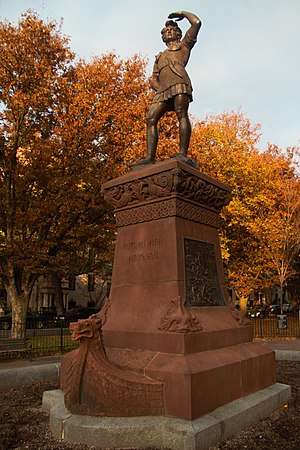Statue of Leif Erikson (Boston)
Leif Eriksson is an outdoor statue by Anne Whitney at the west end of the Commonwealth Avenue Mall in Boston, Massachusetts, United States.[1] Installed in 1887, it was the first public sculpture to honor the Norse explorer in the New World.[2] Later that year a copy, Leif, the Discoverer, was placed in Juneau Park in Milwaukee, Wisconsin.[3]
| Leif Eriksson | |
|---|---|
 The statue from the west in 2019 | |
%26groups%3D_d43758991a34d79daceac4b7929cbbec6e473fad.svg)
| |
| Artist | Anne Whitney |
| Year | 1885 |
| Medium | Bronze sculpture |
| Subject | Leif Erikson |
| Location | Boston, Massachusetts, U.S. |
| 42°20′56.5″N 71°5′29″W | |
Description
The bronze is 102 in (260 cm) tall and stands on a red sandstone pedestal 108 in (270 cm) high, with a small stonework boat at the base.[4] The granite around the sculpture originally served as a fountain, but has since been converted to a flower bed.[5] The work contains runes as well as the English inscription "Leif the Discoverer, Son of Erik, who sailed from Iceland and landed on this continent, AD 1000."[2] It depicts Leif as a young man lifting his left hand to shield his gaze.[6]
History
The memorial was commissioned by the baking powder magnate Eben Norton Horsford, prompted by conversations with Ole Bull and others, to promote the idea of Norse exploration of North America.[5] Its dedication in October 1887 was followed by a big parade through Boston Common to Faneuil Hall.[7]
Whitney corresponded with Frederick Law Olmsted about the placement of the monument and its landscaping.[8] It was later moved for a road realignment.[9] The site was surveyed as part of the Smithsonian Institution's "Save Outdoor Sculpture!" program in 1993.[9] Corrosion was treated in 2007 and an acrylic protective coating was applied.[10]
See also
References
- Burr, Ty (June 4, 2017). "Do Boston's statues honor the truly honorable?". Boston Globe. p. A10.
Leif Eriksson (1887, Anne Whitney, Commonwealth Avenue Mall near Charlesgate)
- Kjaergaard, Thorkild (2010). "An Unnoticed Example of how the Black Death Altered the Course of History: Why America Was Discovered from Spain and not from Scandinavia". Economic and Biological Interactions in Pre-industrial Europe, from the 13th to the 18th Century. By Istituto internazionale di storia economica F. Datini. Settimana di studio, Simonetta Cavaciocchi. Florence: Firenze University Press. p. 269. ISBN 9788884535856.
The Mirage from the North: Leif Eriksson in America
- Rines, George Edwin, ed. (1920). . Encyclopedia Americana – via Wikisource.
- Headley, Janet A. (Summer 2003). "Anne Whitney's Leif Eriksson: A Brahmin Response to Christopher Columbus". American Art. 17 (2): 41–59. doi:10.1086/444690.
- Greis, Gloria Polizzotti (2004). "Vikings on the Charles (OR, The Strange Saga of Norumbega, Dighton Rock, and Rumford Double-Acting Baking Powder)". Needham History Center & Museum.
- Klein, Christopher (November 23, 2013). "Uncovering New England's Viking connections". Boston Globe.
- McCleary, Mary (October 12, 2015). "Columbus and Erikson: the North End and the Southern beginning". New Boston Post. Boston Media Networks. Retrieved 2019-10-25.
- Frederick Law Olmsted (October 31, 2013). The Papers of Frederick Law Olmsted: The Early Boston Years, 1882–1890. JHU Press. p. 326. ISBN 978-1-4214-0926-9.
- "Leif Eriksson, (sculpture)". Smithsonian Institution. Retrieved October 16, 2019.
- "Boston's Adopted Statues: Leif Eriksson Statue". Arts and Culture. City of Boston. Retrieved 2019-10-25.
External links
